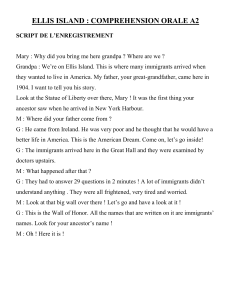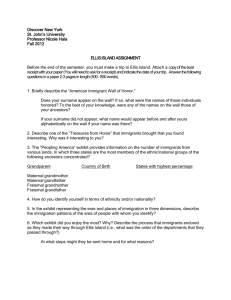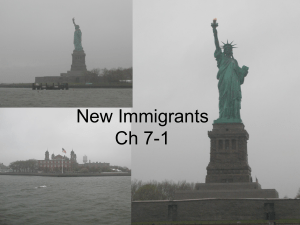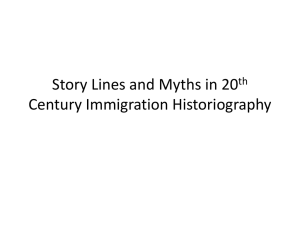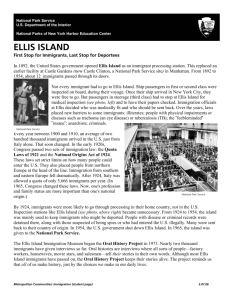Ch. 6 Urban America - Streetsboro City Schools
advertisement
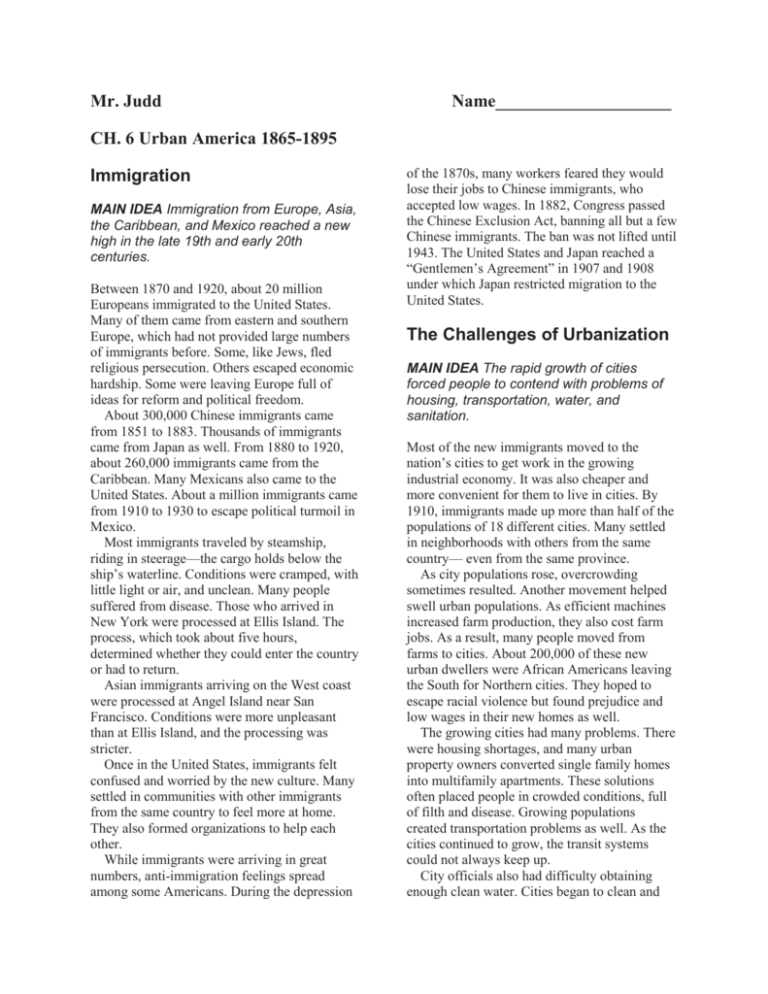
Mr. Judd Name____________________ CH. 6 Urban America 1865-1895 Immigration MAIN IDEA Immigration from Europe, Asia, the Caribbean, and Mexico reached a new high in the late 19th and early 20th centuries. Between 1870 and 1920, about 20 million Europeans immigrated to the United States. Many of them came from eastern and southern Europe, which had not provided large numbers of immigrants before. Some, like Jews, fled religious persecution. Others escaped economic hardship. Some were leaving Europe full of ideas for reform and political freedom. About 300,000 Chinese immigrants came from 1851 to 1883. Thousands of immigrants came from Japan as well. From 1880 to 1920, about 260,000 immigrants came from the Caribbean. Many Mexicans also came to the United States. About a million immigrants came from 1910 to 1930 to escape political turmoil in Mexico. Most immigrants traveled by steamship, riding in steerage—the cargo holds below the ship’s waterline. Conditions were cramped, with little light or air, and unclean. Many people suffered from disease. Those who arrived in New York were processed at Ellis Island. The process, which took about five hours, determined whether they could enter the country or had to return. Asian immigrants arriving on the West coast were processed at Angel Island near San Francisco. Conditions were more unpleasant than at Ellis Island, and the processing was stricter. Once in the United States, immigrants felt confused and worried by the new culture. Many settled in communities with other immigrants from the same country to feel more at home. They also formed organizations to help each other. While immigrants were arriving in great numbers, anti-immigration feelings spread among some Americans. During the depression of the 1870s, many workers feared they would lose their jobs to Chinese immigrants, who accepted low wages. In 1882, Congress passed the Chinese Exclusion Act, banning all but a few Chinese immigrants. The ban was not lifted until 1943. The United States and Japan reached a “Gentlemen’s Agreement” in 1907 and 1908 under which Japan restricted migration to the United States. The Challenges of Urbanization MAIN IDEA The rapid growth of cities forced people to contend with problems of housing, transportation, water, and sanitation. Most of the new immigrants moved to the nation’s cities to get work in the growing industrial economy. It was also cheaper and more convenient for them to live in cities. By 1910, immigrants made up more than half of the populations of 18 different cities. Many settled in neighborhoods with others from the same country— even from the same province. As city populations rose, overcrowding sometimes resulted. Another movement helped swell urban populations. As efficient machines increased farm production, they also cost farm jobs. As a result, many people moved from farms to cities. About 200,000 of these new urban dwellers were African Americans leaving the South for Northern cities. They hoped to escape racial violence but found prejudice and low wages in their new homes as well. The growing cities had many problems. There were housing shortages, and many urban property owners converted single family homes into multifamily apartments. These solutions often placed people in crowded conditions, full of filth and disease. Growing populations created transportation problems as well. As the cities continued to grow, the transit systems could not always keep up. City officials also had difficulty obtaining enough clean water. Cities began to clean and filter the water and insist on indoor plumbing, but these steps spread slowly. Removing waste and garbage was another problem. By 1900 most cities had full-time professional fire departments. But the lack of water made fires very dangerous—and reliance on wood as a building material gave fires fuel to burn. Both Chicago, in 1871, and San Francisco, in 1906, suffered very devastating fires. Another problem of the growing cities was crime. Some social reformers pushed to improve life in the cities. The Social Gospel movement held that Christians had a duty to try to reform conditions. Some reformers created settlement houses. These community centers aimed at helping the poor, especially immigrants. Run mostly by women, they offered schooling, nursing, and other assistance. Politics in the Gilded Age MAIN IDEA Local and national political corruption in the 19th century led to calls for reform. The large populations of cities provided an opportunity for a new political force—the political machine controlled by a boss. A machine was a group that controlled a political party. By giving voters services they needed, the machine won their votes and controlled city government. The city boss controlled the whole machine— and the city government. Bosses controlled jobs in the police, fire, and sanitation departments. They controlled the city agencies that granted licenses to businesses. They controlled the money used to fund large construction projects. Many bosses were first- or second-generation immigrants, and they understood immigrants’ concerns. By helping to solve immigrants’ problems, they won loyalty. Political machines could point to many accomplishments. As they gained power, though, some individuals became corrupt. Some used illegal methods to win elections. Others abused power to become wealthy. Since the bosses controlled the police, they were seldom pursued. The Tweed Ring of New York was one of the most famous examples of corruption among city officials. Boss Tweed and many associates were finally convicted of various crimes. Corruption reached national politics. For many decades, presidents had given jobs to loyal party workers in what was called the spoils system. As a result, some workers were not qualified for their jobs. Others used their positions to get money. Reformers wanted to end these abuses. They proposed a civil service system in which government jobs would go only to those who proved they were qualified. President Rutherford B. Hayes took some steps to reform the federal government. This aroused the anger of some members of his own party. These Stalwarts, as they were called, opposed any changes. The next president, James Garfield, favored the reform movement, and he was shot and killed by an unbalanced Stalwart. His successor, Chester Arthur, pushed through the Pendleton Act of 1883. It created the Civil Service Commission to give government jobs based on merit, not politics. The act helped reform the civil service. However, some politicians now turned to wealthy business leaders for campaign money. As a result, some corruption continued. Another issue was how high to make the tariff, or tax on imported goods. Business leaders and Republicans wanted high tariffs so they could cut foreign competition. Democrats favored low tariffs. Under Republican presidents Benjamin Harrison and William McKinley, the tariff was high. Under Democrat Grover Cleveland, the tariff was lower for a short period. Review Questions (Pgs. 1-2) Mr. Judd Immigration The New Colossus Not like the brazen giant of Greek fame With conquering limbs astride from land to land; Here at our sea-washed, sunset gates shall stand A mighty woman with a torch, whose flame Is the imprisoned lightning, and her name Mother of Exiles. From her beacon-hand Glows world-wide welcome; her mild eyes command The air-bridged harbor that twin cities frame, "Keep, ancient lands, your storied pomp!" cries she With silent lips. "Give me your tired, your poor, Your huddled masses yearning to breathe free, The wretched refuse of your teeming shore, Send these, the homeless, tempest-tossed to me, I lift my lamp beside the golden door!" by Emma Lazarus, New York City, 1883 1. How many immigrants came to America between1870-1920? 2. Where did most of them come from? 3. Why did they come to America? 4. What was their passage to America like? 5. Where was the chief processing center on the east coast? West coast? 6. Where did many immigrants settle once they arrived in America? Why? 7. What law banned Chinese immigration in 1882? 8. What was the “Gentlemen’s Agreement?” The Challenges of Urbanization 9. By 1910, immigrants made up what percentage of the population in many cities in America? 10. What other movement around this time also helped swell the population of urban areas? 11. What problems arose in the growing cities? 12. What was the “Social Gospel” movement? 13. What was a settlement house? Politics in the Gilded Age 14. What was a political machine? 15. What were some ways in which the boss controlled the machine? 16. What was perhaps the most corrupt political machine in America? 17. What was the spoils system? 18. What did reformers propose to end the spoils system? 19. What happened to President Garfield when he supported the reform measure? 20. What was the Pendleton Act of 1883? 21. What is a tariff? Why did Republicans want to raise it? THE LONG, LONG, JOURNEY VIDEO VIEWING GUIDE Mr. Judd 1. What landmark did Janek and his family see as they arrived in the United States? 2. According to the video, what year did Janek and his family arrive in the United States of America? 3. What was Janek’s father’s occupation (job)? 4. What immigration station did Janek’s father go to to pick up his family? 5. What invention was Janek happy to test out again and again when he arrived in the new “skyscraper” apartment? 6. How much money did Janek’s father make per week at his job? 7. What English sound does Janek have a difficult time pronouncing during his classes? 8. Why does Janek get into a fight with the Irish boy at school? 9. Why does Babcia (Grandma) do to punish Janek when he refuses to speak Polish at home? 10. What injury did Janek’s father suffer at work? 11. When Janek goes to talk to his father’s boss about his future with the company, the boss says – 12. What occupation did the Jewish family which lived upstairs from Janek work in? 13. Kasha got married when – 14. Who did Babcia (Grandma) give all of the family’s money to? 15. What did Babcia (Grandma) give to Kasha (sister) when she left the family to get married? 16. Janek explains to his teacher that he must leave school to support his family. He returns her book. Ms. Clarke says, “Now, you’ll never be better that your father!” How does Janek respond? 17. How long was Janek’s shift at the meatpacking plant when he started working there? 18. Janek is happy that he came to the United States and because – Immigration and Ellis Island Directions: Step 1: Go to the following Web site and create a free account (Click on the “yes I am new to this site link”): https://www.ellisisland.org/sign/index.asp?ACT=LL&login_targ=none Step 2: Click the “Passenger Search” tab at the top left of the page. Then, use a real ancestor’s name, use your own last name, of pick any name off of the Ellis Island list, to discover passenger information about someone who entered the United States through Ellis Island. You may use any name off of the list that you want! Step 3: Once you have selected a name, use the Web site to answer the worksheet. You may need to view other areas of the Web site to complete this project. Go to the following link for details about Ellis Island: http://www.ellisisland.org/genealogy/ellis_island.asp ---------------------------------------------------------------------------------------------------------------Part I: Immigrant Record Name of Immigrant _____________________________________________________________________ (Last) (First) (Middle) Ethnicity: ___________________________ Last Place of Residence: Date of Arrival: _________________ Age at Arrival: _______ Gender: Male or Female Ship of Travel: _________________________________ Port of Departure: Part II: Immigrant Processing 1. When did Ellis Island officially open? 2. What type of inspection would a steerage / third class passenger receive upon arrival at Ellis Island? 3. How long would the inspection process usually last? 4. What were the two main reasons an immigrant may be denied entry to America? 5. Between 1892 and 1954, how many people passed through Ellis Island? 6. Go to the “Photo Albums” tab and click on “Ellis Island Then…” Look through the photographs and select your favorite to answer the questions below: A. Describe the photograph B. What might the people in the photograph be thinking? C. Do the people look happy or sad? Explain why you think they feel that way: D. List three challenges these new immigrants will face once they are admitted into the United States: 7. What was the name of the first person to be registered at Ellis Island? 8. Under the “Timeline” section, view the “Peopling of America” Chart section 1880-1930. What ethnic group was severely restricted in entering the United States in 1882? 9. Where is Ellis Island located? 10. What year did Ellis Island officially close? The Populist Movement Read Pgs. 242- 244 in your text and list AT LEAST FOUR problems Midwestern farmers experienced between 1870 and 1900 1. _________________________________________________________________________________ _________________________________________________________________________________ 2. _________________________________________________________________________________ _________________________________________________________________________________ 3. _________________________________________________________________________________ _________________________________________________________________________________ 4. _________________________________________________________________________________ _________________________________________________________________________________ In response to these problems, farmers formed the ___________ Party, a third party. What is a third party? A party that addresses an issue or represents a group that the two major parties (Democrats and Republicans) are ignoring. ____________________________________________________________________________ The Populist Party Platform Problem Solution Description “Bimetallism:” print paper money backed by gold AND silver. A shortage of gold caused a shortage of paper money, which made it hard for farmers to get loans and pay back their debts. Silver was more plentiful and if more silver was coined, more paper money would be available to help farmers pay down their debts. Gold Standard- 1 oz. gold = $1 Bimetallism- 16 oz. of silver = $1 The Interstate Commerce Act A Tariff on European Farm Goods Have the government pass a law to take over or heavily control/regulate the railroad industry to prevent them from charging exorbitant rates. In order to reduce the supply of crops, place an import tax (a tariff) on European crops coming into America. This would make them more expensive and therefore discourage Europeans from exporting them. 16th Amendment (Graduated or Progressive income tax) 17th Amendment (Direct election of U.S. Senators) A tax on individual’s income (rather than just the property they own) would help to shift the tax burden to all the residents of cities who don’t own lots of land. The more money you make, the more you pay. In order to prevent businesses from bribing U.S. Senators, have the people directly elect the Senators (rather than have the state legislatures pick them). So………what happened to the Populists? Prior to the presidential election of 1896, the Populist Party had so many followers that Democrats (who historically have represented farmers) began to worry that they would lose the election if the Populist Party nominated their own presidential candidate. So the Democrats decided to run the candidate that the Populists wanted: William Jennings Bryan. Bryan gave a very famous speech entitled “The Cross of Gold” speech at the Democratic Party’s nominating convention at which he announced the most important issue facing farmers: “If they dare to come out in the open field and defend the gold standard as a good thing, we shall fight them to the uttermost, having behind us the producing masses of the nation and the world. Having behind us the commercial interests and the laboring interests and all the toiling masses, we shall answer their demands for a gold standard by saying to them, you shall not press down upon the brow of labor this crown of thorns. You shall not crucify mankind upon a cross of gold.” In the end, the Republican Party candidate William McKinley defeated the Populist backed candidate William Jennings Bryan. If Bryan ran a campaign based on the message that corporations had grown too powerful and government needed to address the concerns of the common people, how did he lose? Common people make up the majority of the country? ********So why should I care about the stupid farmers and their Populist Party?************* Reason #1: The Populist Party was an influential third party that made a big impact on American politics. Even today, the word “populist” is still used to describe politicians who advocate policies that benefit common people. Reason #2: The loss of the Populist candidate (Bryan) symbolized the transition of America from a rural, agrarian society to an urban, industrial society. Farming was not as important anymore! Reason #3: The Populists were the first party to call on the government to take action and regulate the economy during an era when most people believed in Social Darwinism and laissez-faire. Reason #4: The Populists were the first group of people to raise a question that still is being asked today: should government policies benefit big businesses or average people?

